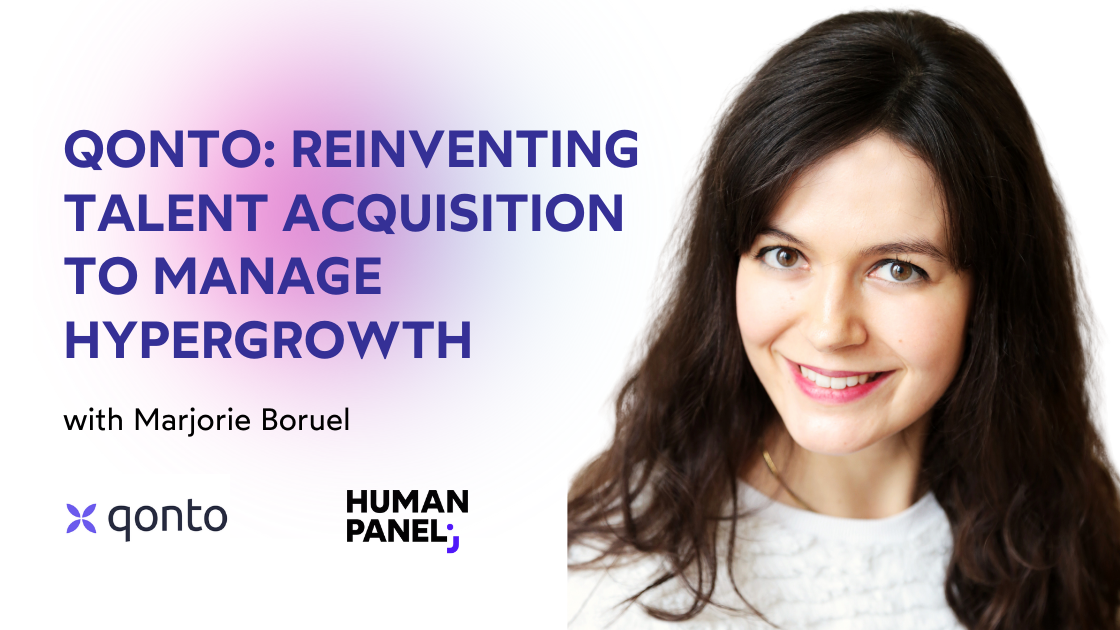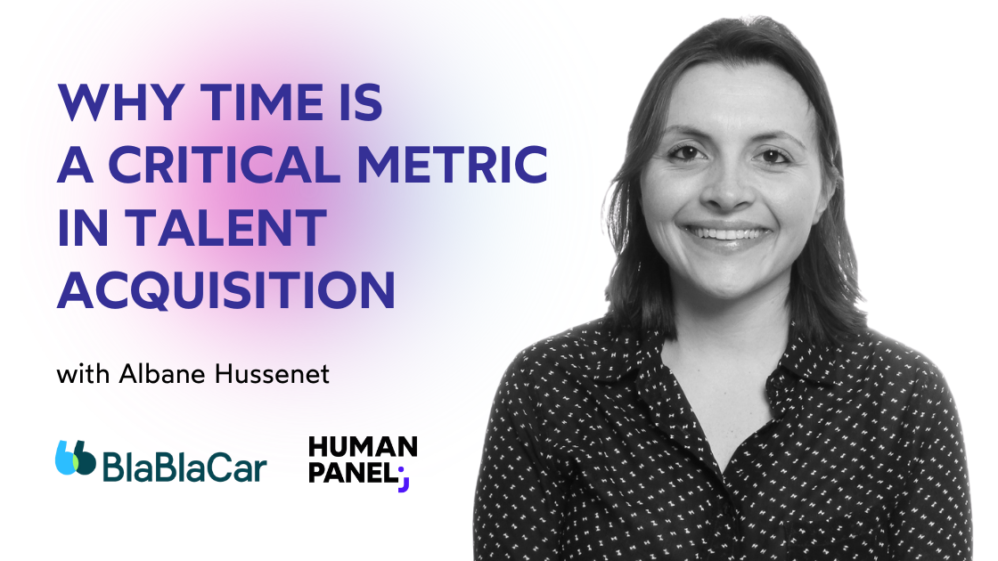Reinventing talent acquisition to manage hypergrowth – with Qonto

Marjorie Boruel, Head of Talent Acquisition at Qonto shared with us how the TA team supports business in hiring to make the company stand out from the crowd.
The idea of Qonto came from the frustration of the company’s founders – Alexandre Prot and Steve Anavi – with the banking experience. In 2017 they started working on their own banking product. Now it is an all-in-one business account for SMEs and freelancers with simplified accounting, top-notch customer service and transparent pricing, trusted by 220,000 businesses.
The company employs a team of 500 people and is on a continuous growth path. Qonto’s product is already available in France, Germany, Italy and Spain. As recently as 2021, the Paris-based company has hired more than 400 employees, doubling its size.
The challenges were great, and hiring good talent quickly was one of the most important. How did Qonto’s team grow so quickly in just a few months? How can you get results when hypergrowth and fierce competition collide?
Human Panel had the opportunity to speak with Marjorie Boruel, Head of Talent Acquisition at Qonto. She shared with us some invaluable insights from her experience at Qonto. She told us how she structured the team at TA and how the philosophy of the Qonto Way contributes to the company’s success.
Human Panel: Great to meet you, Marjorie! Can you tell me more about your role at Qonto and the Talent Acquisition team that you’re leading?
Marjorie Boruel, Head of Talent Acquisition at Qonto: I have been leading the Talent Acquisition team at Qonto for more than three years. Currently, we are 21 people within two main teams.
The first is responsible for recruiting the Tech team and the Product team, while the second takes care of filling positions in the Corporate, Operations and Growth teams. This means that our Talent Acquisition Managers are assigned by area of expertise and depending on the scope of the hires.
In 2022, we want to increase the number of Talent Acquisition Managers. However, my priority is to hire or promote more team leaders and create new positions that are critical to scaling effectively – such as the TA Coordinator, TA Sourcer and Growth Recruiter. We also want to have TAMs who specialize in specific geographic locations. Last July, we opened offices in Germany, Italy and Spain, and we want to hire TAMs for those markets.
What role does data play in your work?
It’s important for a Talent Acquisition team to be data-driven. Without data, you are blind and cannot develop an effective strategy. We do not yet have a team dedicated solely to analyzing data for recruiting purposes, but data is embedded in our thinking from the start.
Analyzing the data also allows us to measure our own efficiency and shows us how we can recruit faster without compromising the quality of our hires.
You wrote in your article for Medium that the biggest challenge is “finding the balance between hiring fast and hiring well”.
That is indeed the challenge we face every day. Of course, you always want to hire the best people, but if it takes six months, that’s not good for the company. On the other hand, at Qonto we do not want to rush things, because then it’s easy to lose control. So yes – talent acquisition is a constant struggle to balance high quality hires with reducing the time needed for the process.
So is time a critical metric for a talent acquisition team at Qonto?
At Qonto, we have decided to use time as a key performance indicator. If we do not meet deadlines or are late, we either have a problem or we need to work on improving the system to successfully deliver on time:
- The time it takes a candidate to complete the recruitment process,
- The time it takes us to recruit, or, similarly, the recruitment pace for recurring positions that are constantly open.
This time provides insight into the quality of our work and indicates whether we are able to recruit the best talent in the first round.

When we are faced with a problem (for example, not being able to close a position within 30 days), we get to the bottom of it and check the conversion rate at every step of our process. By testing and analyzing different ideas, we were able to shorten the time it takes to fill a position by one week last year.
In addition, for our recurring positions, we try to anticipate and define how many candidates we need at each step of the process to be able to hire one at the end.
Finally, to measure our quality, we monitor churn after the probationary period.
What tools help you navigate this wealth of information?
Because recruitment is key to the success of any fast-growing company, talent acquisition teams today have a variety of tools to choose from. But the most important factor is how we use them.
In my opinion, the most important tools are the following:
- A good ATS with CRM capabilities so you can launch email campaigns and track your candidates with up-to-date data.
- Access to LinkedIn, because this is the most important business network in the world.
- A really well-designed career website to attract candidates.
Then you can add other specific tools:
- A tool to drive internal referrals (to get your employees more involved).
- A data visualization tool for current market trends (where are candidates located, what is their background, what is the average salary, etc.).
- All the tools used by the growth teams (in paid acquisition to better target candidates with job ads, in the sales department to better identify certain profiles that are not visible on the market, etc.).
Right now, we are working with our BI team to go beyond what we have done so far and visualize our data in real-time.
Why is this data visualization important?
If you want to make progress, you must first have a clear idea of the challenges. Therefore, it is important to visualize all the steps of the recruitment process. We can then easily see at which step of the process a problem occurred and thus think about corrective actions.

Let us visualize it in black and white:
- Who is working on what to take stock at the beginning of each day and ensure that the right priorities are set?
- What problems have arisen that we need to file in our “red boxes”? Similarly, we go through these issues every day as a team to find solutions as they arise and to develop good practices for the long term.
- What are our successes (of course, our “green boxes”) that help us understand why we were successful and how we can repeat that success?
In addition, every morning we take a long, hard look at our machine and scrutinize each of its working parts. This helps us ask the right questions and continuously optimize the system.

What relevant trends have you discovered thanks to the analysis of the data?
For example, we used to schedule an interview between the candidate and some members of the team right after debriefing the competency tests. The conversion rate at this step was over 90%. This meant that our strategy here was inefficient and time-consuming.
We decided to make the test optional and only when requested by the candidate.
So how do you structure your talent acquisition process “the Qonto way”?
The first step is to understand our “customers.” On one hand, we do everything we can to attract candidates efficiently. On the other hand, we want our recruiters to be happy with their new hires. Our goal is for both sides to be satisfied with the choice they make.
One of the key factors in this is understanding the unique challenges our “clients” face. At Qonto, recruiters attend meetings with the teams for which they are hiring. They may even spend time working with the teams to get a feel for their expectations on the ground. This is how we build a strong business relationship.
Once we have accomplished this, we take time to determine what talent we need, what positions we want to fill, and on what team. To do this, we conduct exercises that help us ask the right questions, such as:
- Why is this role important at Qonto?
- Why do we need this position right now (team and organization)?
- What will be the job of the person we hire (try to go beyond the job description in the job ad)?
- What does a typical week look like for the selected candidate?
- What technical skills and soft skills are required for success?
- What criteria will we use to evaluate the candidate?
- Who will be involved in the hiring process and what will each person’s role be?
- What is our sourcing strategy?
This persona is our foundation, our roadmap, our cornerstone between recruiters and managers. We will be guided by it throughout the process, but we will also make changes as we learn more.

Throughout the process, we schedule regular weekly meetings between the recruiter and the manager. We do this because we believe that the more the manager invests in the recruiter, the better the results in terms of efficiency and quality of hires.
Let us take candidate sourcing as an example. At Qonto, we believe that sourcing candidates is the recruiter’s job, not the manager’s. And why?
- Sourcing candidates takes time away from the manager’s usual duties.
- We may have no record of communication between the manager and the candidate, and this potential lack of coordination could make the company look unprofessional if the recruiter contacts the candidate again.
- The tone and content of the message sent to candidates may be inconsistent if it is written by multiple people. Also, a recruiter invests a lot of time in crafting recruitment messages to make them relevant.
- The quality of the screening process (a step in which resumes or profiles are evaluated) is also prone to inconsistency because while you may have a good sense of the qualities you are looking for, it is difficult to decipher them in a resume.
At Qonto, a recruiter searches for candidates and sends the first message to the candidate, which is also approved by the manager. Then the manager sends a message to the candidate to confirm our interest.
We find this technique very effective because it is truly personal and shows the candidate that we have taken the time to fully study and review their profile. It highlights our team spirit and the candidate knows that the manager and recruiter are working together. That, in turn, builds trust.
When managers and recruiters coordinate and combine their areas of expertise and each works towards success, the chance of recruiting the best talent at the right pace increases.
Marjorie Boruel
What about the candidate experience?
Our goal is to provide an excellent candidate experience that reflects Qonto’s values. That means we want our candidates to believe it’s worth investing time in the hiring process – even if they do not end up getting the job. Recruitment is not just a test – it’s an opportunity to improve and grow.
According to the data, every one of us has had at least one bad job search experience. At Qonto, we want to fight stereotypes and not just evaluate our candidates, but create an enjoyable and stimulating interaction. That’s why our recruiters provide feedback or even coaching support to candidates. They guide our candidates through every step of the process.
Even if someone is not successful in our recruiting process, we refer candidates to other companies. He or she may not be a perfect fit for us, but a good fit at another startup. It’s a win-win situation, and the referred candidates usually give very positive feedback after the hiring process.
What advice would you give to talent acquisition specialists and recruiters looking to work with data? How can you not be overwhelmed by the amount of information you collect?
The most important thing is to analyze and understand the story behind the numbers. As a recruiter, you need to read data to understand the market and track trends. That can be a challenge, especially if you are a global recruiter. But I would say you need to focus on analyzing the trends and try to stay ahead of the curve. Then you have a high chance of success.
Would you like to visualize all the data in your talent acquisition process? Integrate the data from your ATS and other sources you use in talent acquisition. Sign up for a free trial of Human Panel and see the difference.




